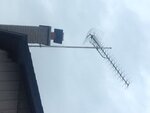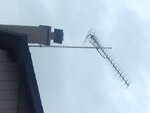Externet
Advanced Member level 2
- Joined
- Jan 29, 2004
- Messages
- 579
- Helped
- 28
- Reputation
- 58
- Reaction score
- 29
- Trophy points
- 1,308
- Location
- Mideast US
- Activity points
- 5,664
Hi all.
I find the subject way off reality.
Impedances are tied to a frequency, and rating tuners as for 75Ω, makes no sense in a span from ~50MHz to ~800MHz. It may hit 75Ω at a few places, but in general, it is a lie.
Same with television antennas. Rated 75Ω for similar span. That cannot be right. But has been like that and accepted since day one.
I suspect modern tuners are much higher impedance, but data sheets are very hidden or just unpublished as even the manufacturers may not know the exact specifications, or conflict with 'nominal standards'. Being much higher impedance tuner inputs, nears irrelevancy. A low impedance source antenna can feed a high impedance tuner very well, no power transfer matching needed. But the reception voltage would increase with proper matching and improve sensitivity to marginal signals.
But still the industry uses 75Ω cables and antennas.
What is your opinion or approach to design a plain TV antenna and feed line to really perform when feeding modern tuners ? -Thinking out of the 75Ω box-
Is there any pertinent study about receiving the best optimal signal in what normally is trial and error and guessing ?
Seen 'super' and expensive TV antennas, surpassed in performance by a properly positioned piece of coat hanger, and sometimes by an unterminated piece of RG59 or RG whatever (behave the same!) tossed behind a piece of furniture and fixed there at the best position and shape.
I find the subject way off reality.
Impedances are tied to a frequency, and rating tuners as for 75Ω, makes no sense in a span from ~50MHz to ~800MHz. It may hit 75Ω at a few places, but in general, it is a lie.
Same with television antennas. Rated 75Ω for similar span. That cannot be right. But has been like that and accepted since day one.
I suspect modern tuners are much higher impedance, but data sheets are very hidden or just unpublished as even the manufacturers may not know the exact specifications, or conflict with 'nominal standards'. Being much higher impedance tuner inputs, nears irrelevancy. A low impedance source antenna can feed a high impedance tuner very well, no power transfer matching needed. But the reception voltage would increase with proper matching and improve sensitivity to marginal signals.
But still the industry uses 75Ω cables and antennas.
What is your opinion or approach to design a plain TV antenna and feed line to really perform when feeding modern tuners ? -Thinking out of the 75Ω box-
Is there any pertinent study about receiving the best optimal signal in what normally is trial and error and guessing ?
Seen 'super' and expensive TV antennas, surpassed in performance by a properly positioned piece of coat hanger, and sometimes by an unterminated piece of RG59 or RG whatever (behave the same!) tossed behind a piece of furniture and fixed there at the best position and shape.


